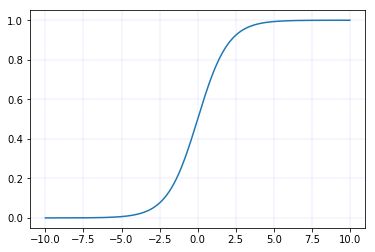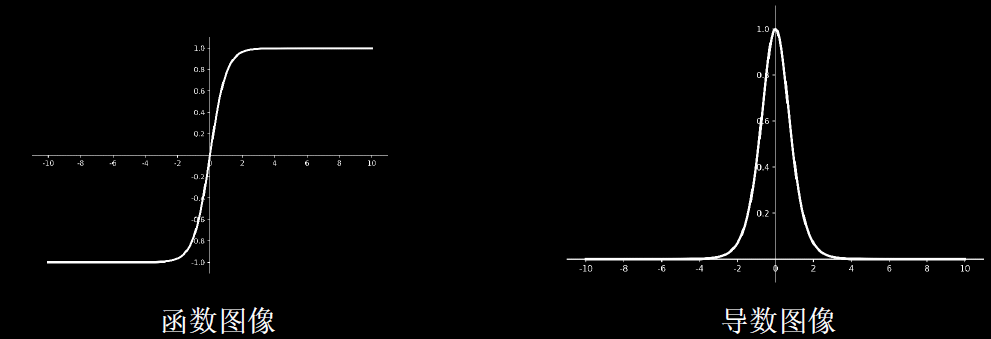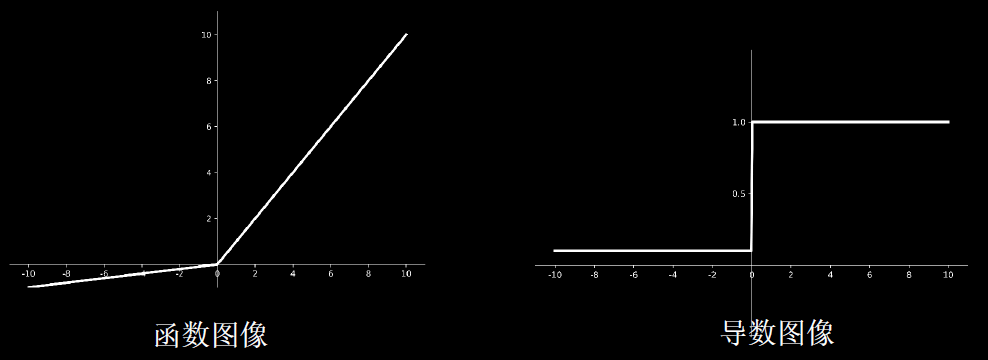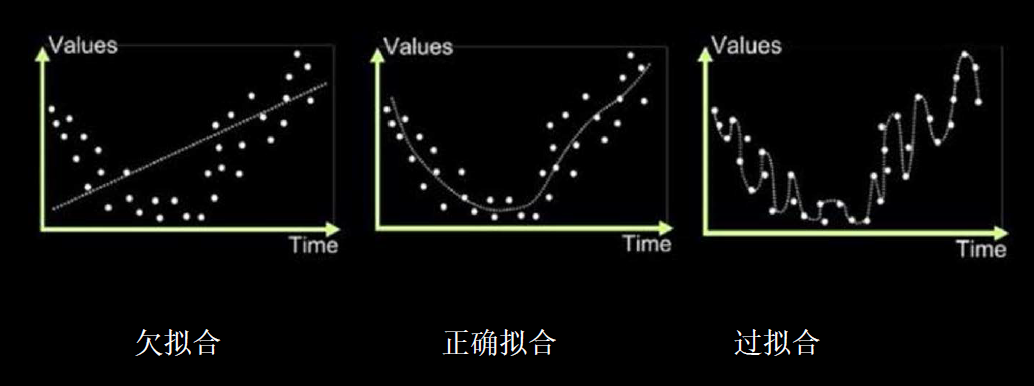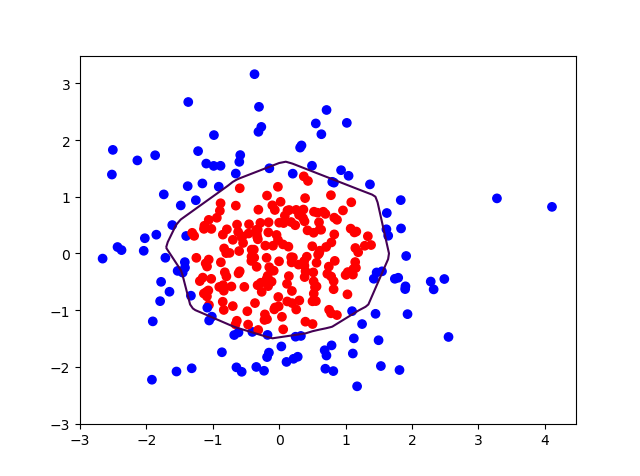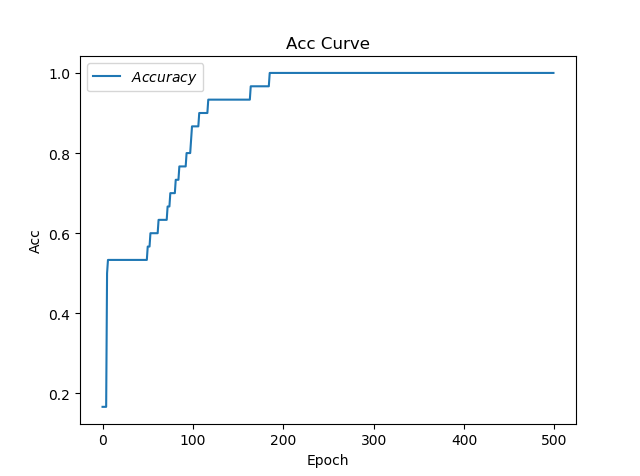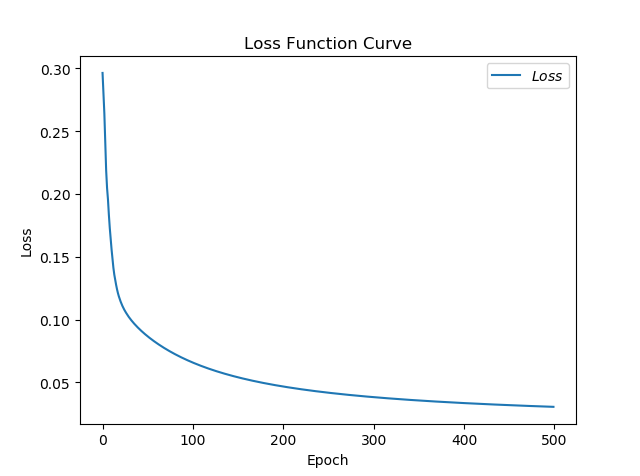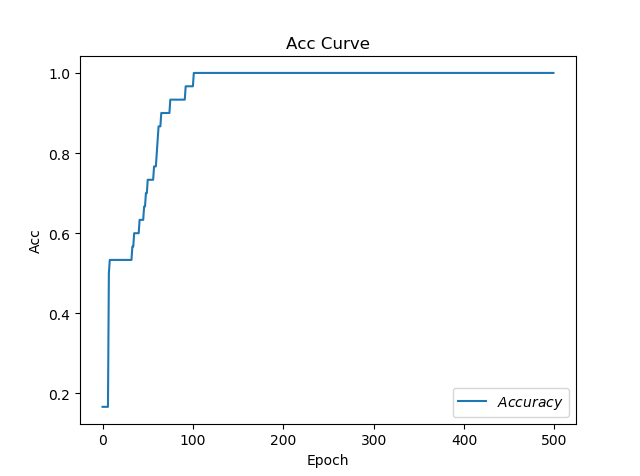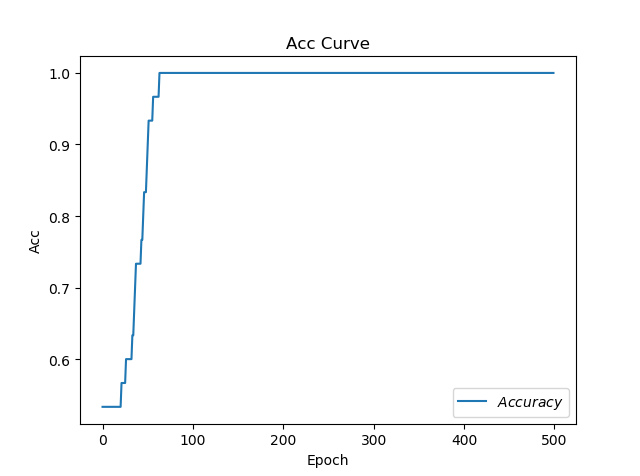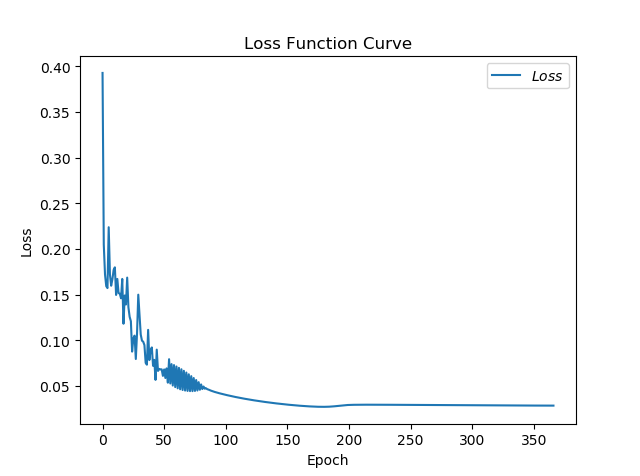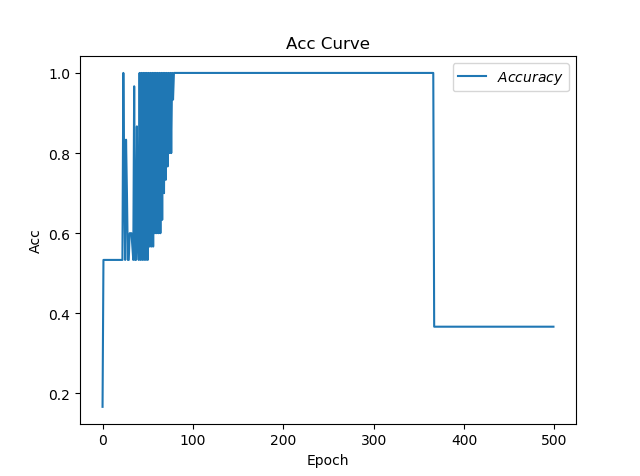本文已收录到:人工智能实践:Tensorflow笔记 专题
预备知识
tf.where()
条件语句真返回A,条件语句假返回B
tf.where(条件语句,真返回A,假返回B)
代码示例
import tensorflow as tf
a = tf.constant([1, 2, 3, 1, 1])
b = tf.constant([0, 1, 3, 4, 5])
c = tf.where(tf.greater(a, b), a, b) # greater函数判断a > b,若a > b,返回a对应位置的元素,否则返回b对应位置的元素
print("c:", c)
运行结果

np.random.RandomState.rand()
返回一个[0,1)之间的随机数
np.random.RandomState.rand(维度) # 若维度为空,返回标量
代码示例
import numpy as np
rdm = np.random.RandomState(seed=1)
a = rdm.rand()
b = rdm.rand(2, 3)
print("a:", a)
print("b:", b)
运行结果

np.vstack()
将两个数组按垂直方向叠加
np.vstack(数组1,数组2)
代码示例:
import numpy as np
a = np.array([1, 2, 3])
b = np.array([4, 5, 6])
c = np.vstack((a, b))
print("c:\n", c)
运行结果

生成网格坐标点
np.mgrid[ ]np.mgrid[起始值:结束值:步长,起始值:结束值:步长,... ]- [起始值,结束值),区间左闭右开
x.ravel()将x变为一维数组,“把.前变量拉直”np.c_[]使返回的间隔数值点配对np.c_ [数组1,数组2,... ]
代码示例:
import numpy as np
import tensorflow as tf
# 生成等间隔数值点
x, y = np.mgrid[1:3:1, 2:4:0.5]
# 将x, y拉直,并合并配对为二维张量,生成二维坐标点
grid = np.c_[x.ravel(), y.ravel()]
print("x:\n", x)
print("y:\n", y)
print("x.ravel():\n", x.ravel())
print("y.ravel():\n", y.ravel())
print('grid:\n', grid)
运行结果
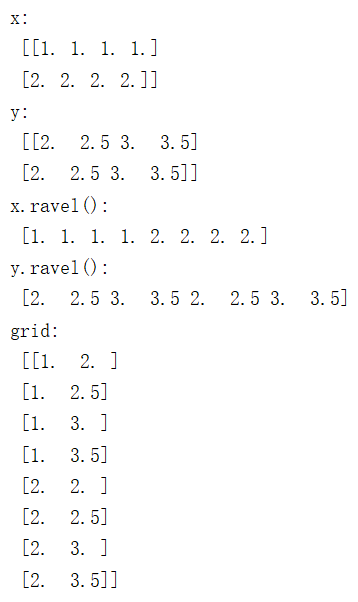
np.mgrid[起始值:结束值:步长,起始值:结束值:步长]填入两个值,相当于构建了一个二维坐标,很坐标值为第一个参数,纵坐标值为第二个参数。
例如,横坐标值为[1, 2, 3],纵坐标为[2, 2.5, 3, 3.5]
x, y = np.mgrid[1:5:1, 2:4:0.5]
print("x:\n", x)
print("y:\n", y)
这样x和y都为3行4列的二维数组,每个点一一对应构成一个二维坐标区域
x:
[[1. 1. 1. 1.]
[2. 2. 2. 2.]
[3. 3. 3. 3.]]
y:
[[2. 2.5 3. 3.5]
[2. 2.5 3. 3.5]
[2. 2.5 3. 3.5]]
复杂度和学习率
神经网络复杂度
神经网络的复杂度分为空间复杂度和时间复杂度。
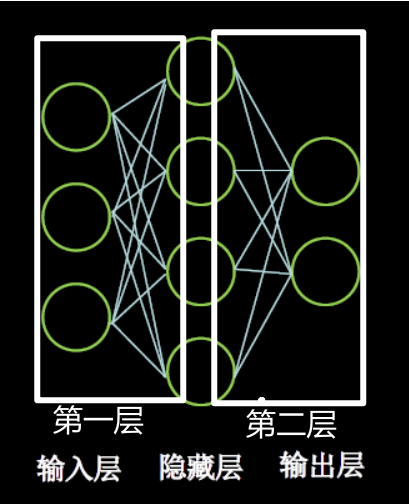
NN复杂度:多用NN层数和NN参数的个数表示
空间复杂度:
层数=隐藏层的层数+ 1个输出层(输入层不参与运算,所以不计算空间复杂度)
图中为:2层NN
总参数=总w+总b
第1层:3×4+4
第2层:4×2+2
图中共计:(3×4+4) +(4×2+2) = 26
时间复杂度:
乘加运算次数
第1层:3×4
第2层:4×2
图中共计:3×4 + 4×2 = 20
学习率
$$ w_{t+1}=w_{t}-l r * \frac{\partial l o s s}{\partial w_{t}} $$
参数说明
- 更新后的参数
- 当前参数
- 学习率
- 损失函数的梯度(偏导数)
指数衰减学习率
在之前的学习率部分中,我们发现学习率设置的要么是不收敛、要么是过慢。
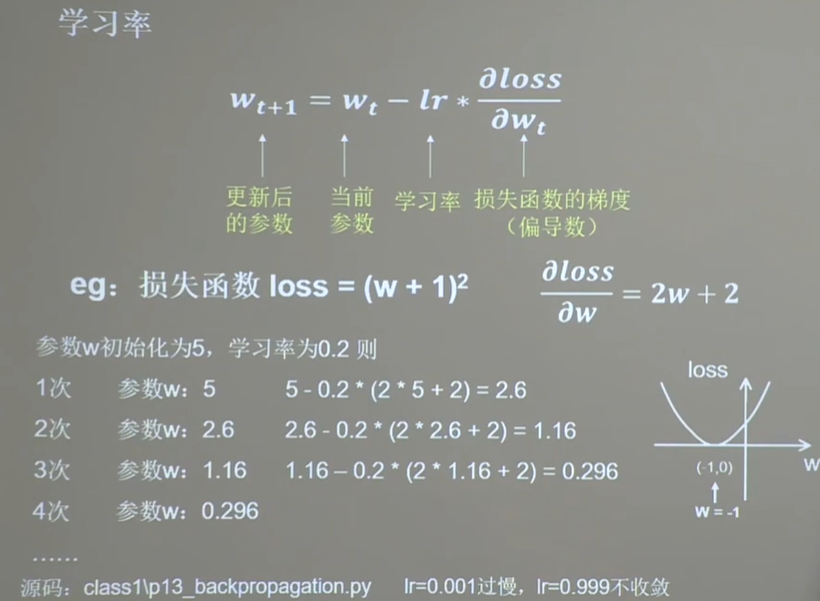
在实际使用中如何快速的找到最优解呢?——使用指数衰减学习率。
可以先用较大的学习率,快速得到较优解,然后逐步减小学习率,使模型在训练后期稳定。
![]()
上图中绿色部分是超参数。
代码示例
下图白框部分是在原有代码基础上添加的,可以使得学习率指数递减。

运行结果,学习率lr在指数衰减

激活函数
为什么要用激活函数:在神经网络中,如果不对上一层结点的输出做非线性转换的话,再深的网络也是线性模型,只能把输入线性组合再输出,不能学习到复杂的映射关系,因此需要使用激活函数这个非线性函数做转换。
为什么要引入非线性函数,请回顾 –> https://gaozhiyuan.net/machine-learning/artificial-neural-network.html#ren_gong_zhi_neng_de_di_yi_ci_han_dong_ri_chang_zhong_de_hen_duo_wen_ti_shi_fei_xian_xing_ke_fen_de
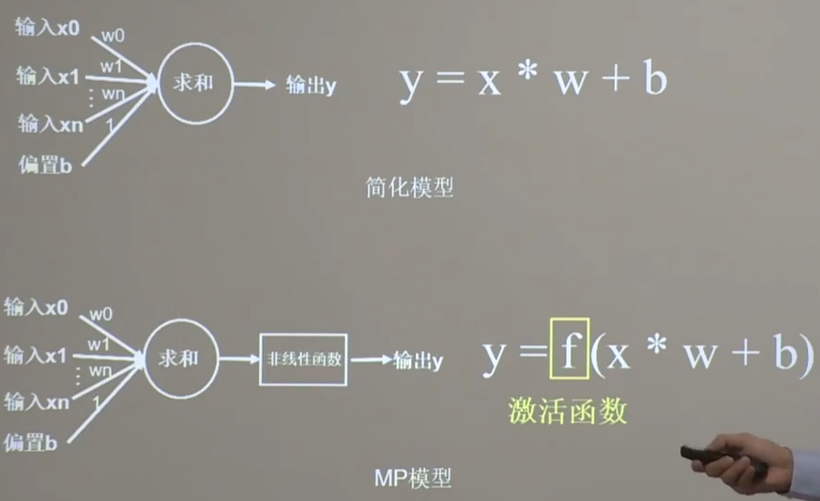
加入了激活函数后可以大大的提高模型的表达能力。
什么样的激活函数才优秀?

Sigmoid函数
$$ \begin{aligned} &\operatorname{sigmod}(x)=\frac{1}{1+e^{-x}} \in(0,1)\ &\operatorname{sigmod}^{\prime}(x)=\operatorname{sigmod}(x)^{*}(1-\operatorname{sigmod}(x))=\frac{1}{1+e^{-x}} * \frac{e^{-x}}{1+e^{-x}}=\frac{e^{-x}}{\left(1+e^{-x}\right)^{2}} \in(0,0.25) \end{aligned} $$
tf.nn.sigmoid(x)
sigmoid函数图像
sigmoid导数图像
Ps:目前使用sigmoid函数为激活函数的神经网络已经很少了。
特点
(1)易造成梯度消失
深层神经网络更新参数时,需要从输入层到输出层,逐层进行链式求导,而 sigmoid 函数的导数输出为[0,0.25]间的小数,链式求导需要多层导数连续相乘,这样会出现多个[0,0.25]间的小数连续相乘,从而造成结果趋于0,产生梯度消失,使得参数无法继续更新。
(2)输出非0均值,收敛慢
希望输入每层神经网络的特征是以0为均值的小数值,但 sigmoid 函数激活后的数据都时整数,使得收敛变慢。
(3)幂运算复杂,训练时间长
sigmoid 函数存在幂运算,计算复杂度大。
Tanh函数
$$ \begin{array}{l} \tanh (x)=\frac{1-e^{-2 x}}{1+e^{-2 x}} \in(-1,1) \ \tanh ^{\prime}(x)=1-(\tanh (x))^{2}=\frac{4 e^{-2 x}}{\left(1+e^{-2 x}\right)^{2}} \in(0,1] \end{array} $$
特点
(1)输出是0均值。
(2)依然存在梯度消失问题。
问:什么是梯度?
答:梯度就是矩阵的导数。
问:这里的梯度消失是什么意思?
答:就比如说正方向x有一个很大的数字,例如是100,它对应的y值无限的接近于1。如果是1000,也是无限接近于1。如果我们把这两个x都输出为1的话,就无限体现出他们在x轴上的100和1000接近十倍的差距。——这巨大的差距被忽略了,这就叫梯度消失。从数学的角度来说就是一个很小的数对其求导,求着求着发现无限接近于0了。
(3)幂运算复杂,训练时间长。
Relu函数
$$\begin{array}{l}r e l u(x)=\max (x, 0)=\left\{\begin{array}{l}x, \quad x \geq 0 \\0, \quad x<0\end{array} \in[0,+\infty)\right. \\r e l u^{\prime}(x)=\left\{\begin{array}{ll}1, & x \geq 0 \\0, & x<0\end{array} \in\{0,1\}\right.\end{array}$$
tf.nn.relu(x)
优点:
- 解决了梯度消失问题(在正区间)
- 只需判断输入是否大于0,计算速度快。
- 收敛速度远快于 sigmoid 和 tanh。
缺点:
- 输出非0均值,收敛慢
- Dead ReIU问题:某些神经元可能永远不会被激活,导致相应的参数永远不能被更新。所以要避免过多的负数特征进入ReLU函数。
Leaky Relu函数
$$\begin{aligned}
&\text { LeakyReLU }(x)=\left\{\begin{array}{ll}
x, & x \geq 0 \\
a x, & x<0
\end{array} \in R\right.\\
&\text { LeakyReL } U^{\prime}(x)=\left\{\begin{array}{ll}
1, & x \geq 0 \\
a, & x<0
\end{array} \in\{a, 1\}\right.
\end{aligned}$$
tf.nn.leaky_relu(x)
理论上来讲,Leaky Relu有 Relu 的所有优点,外加不会有 Dead Relu 问题,但是在实际操作当中,并没有完全证明 Leaky Relu 总是好于Relu。
总结
- 首选 relu 激活函数;
- 学习率设置较小值;
- 输入特征标准化,即让输入特征满足以0为均值,1为标准差的正态分布;
- 初始参数中心化,即让随机生成的参数满足以0为均值,以$$ \sqrt{\frac{2}{\text { 当前层输入特征个数 }}} $$为标准差的正态分布
损失函数
损失函数(loss) :预测值(y) 与已知答案(y_) 的差距
NN优化目标:使loss最小。主流的loss有以下三种方法:
- mse (Mean Squared Error)
- 自定义
- ce (Cross Entropy)
均方误差MES
$$ \operatorname{MSE}\left(y_{-}, y\right)=\frac{\sum_{i=1}^{n}\left(y-y_{-}\right)^{2}}{n} $$
TensorFlow中使用这个方法来使用MES:loss_mse = tf.reduce_mean(tf.square(y_ - y))
eg:预测酸奶日销量 y,验证 x1和 x2是影响日销量的因素。
建模前,应预先采集的数据有:每日x1、x2和当天的销量y_ (即已知答案,最佳情况:产量=销量)
拟造数据集X,Y_ : y_ =x1 + x2,噪声: -0.05~ +0.05
拟合可以预测销量的函数
代码示例
import tensorflow as tf
import numpy as np
SEED = 23455
rdm = np.random.RandomState(seed=SEED) # 生成[0,1)之间的随机数
x = rdm.rand(32, 2) # 生成32行2列的输入特征x
# 构建标准答案y_
y_ = [[x1 + x2 + (rdm.rand() / 10.0 - 0.05)] for (x1, x2) in x] # 生成噪声[0,1)/10=[0,0.1); [0,0.1)-0.05=[-0.05,0.05)
x = tf.cast(x, dtype=tf.float32)
w1 = tf.Variable(tf.random.normal([2, 1], stddev=1, seed=1))
epoch = 15000 # 数据集迭代次数
lr = 0.002 # 学习率
for epoch in range(epoch):
with tf.GradientTape() as tape:
y = tf.matmul(x, w1) # 前向传播结果y
loss_mse = tf.reduce_mean(tf.square(y_ - y)) # 均方误差
grads = tape.gradient(loss_mse, w1) # 求偏导
w1.assign_sub(lr * grads)
if epoch % 500 == 0:
print("After %d training steps,w1 is " % (epoch))
print(w1.numpy(), "\n")
print("Final w1 is: ", w1.numpy())
运行结果
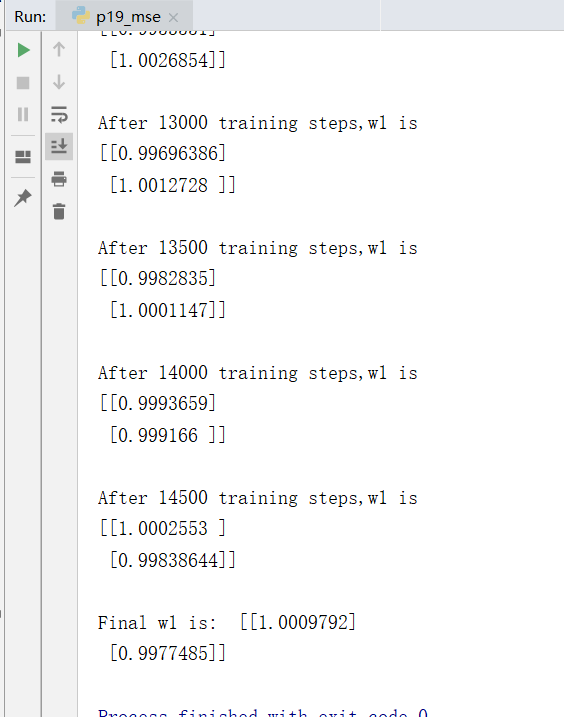
自定义损失函数
预测商品的销量,预测多了,损失成本。但如果预测少了,损失利润。一般情况下利润≠成本,使用MSE产生的loss无法使得利益最大化。
所以我们尝试使用自定义的损失函数。
自定义损失函数,y_:标准答案数据集的,y:预测答案计算出的 $$\operatorname{loss}\left(y_{-} y\right)=\sum_{n} f\left(y_, y\right)$$
把损失定义为一个分段函数:
$$f\left(y_{-}, y\right)=\left\{\begin{array}{lll}\text { PROFIT* }\left(y_{-}-y\right) & y<y_{-} & \text {预测的 } y\text { 少了, 损失利高(PROFIT) } \\ \text { COST } *\left(y-y_{-}\right) & y>=y_{-} & \text {预测的 } y \text { 多了,损失成本(COST) }\end{array}\right.$$
如:预测酸奶销量,酸奶成本(COST) 1元,酸奶利润(PROFIT) 99元。
预测少了损失利润99元,大于预测多了损失成本1元。预测少了损失大,希望生成的预测函数往多了预测。
则损失函数为
loss = tf.reduce_sum(tf.where(tf.greater(y, y_), (y - y_) * COST, (y_ - y) * PROFIT))
代码示例
import tensorflow as tf
import numpy as np
SEED = 23455
COST = 99
PROFIT = 1
rdm = np.random.RandomState(SEED)
x = rdm.rand(32, 2)
y_ = [[x1 + x2 + (rdm.rand() / 10.0 - 0.05)] for (x1, x2) in x] # 生成噪声[0,1)/10=[0,0.1); [0,0.1)-0.05=[-0.05,0.05)
x = tf.cast(x, dtype=tf.float32)
w1 = tf.Variable(tf.random.normal([2, 1], stddev=1, seed=1))
epoch = 10000
lr = 0.002
for epoch in range(epoch):
with tf.GradientTape() as tape:
y = tf.matmul(x, w1)
loss = tf.reduce_sum(tf.where(tf.greater(y, y_), (y - y_) * COST, (y_ - y) * PROFIT))
grads = tape.gradient(loss, w1)
w1.assign_sub(lr * grads)
if epoch % 500 == 0:
print("After %d training steps,w1 is " % (epoch))
print(w1.numpy(), "\n")
print("Final w1 is: ", w1.numpy())
# 自定义损失函数
# 酸奶成本1元, 酸奶利润99元
# 成本很低,利润很高,人们希望多预测些,生成模型系数大于1,往多了预测
自定义损失函数,酸奶成本1元, 酸奶利润99元,成本很低,利润很高,人们希望多预测些,生成模型系数大于1,往多了预测。运行结果

自定义损失函数,酸奶成本99元, 酸奶利润1元,成本很高,利润很低,人们希望多少预测,生成模型系数小于1,往少了预测。运行结果
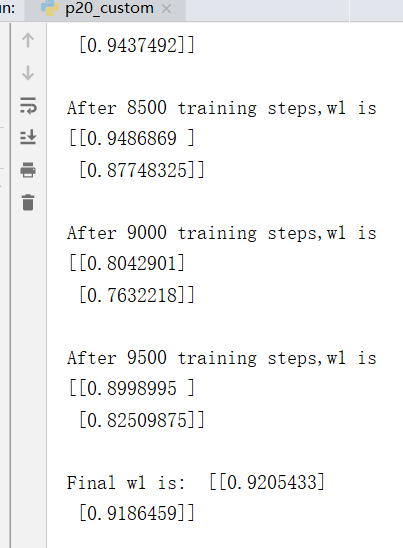
交叉熵损失函数
交义熵损失函数CE (Cross Entropy)可以表示两个概率分布之间的距离 $$ \mathrm{H}\left(\mathrm{y}_{-}, \mathrm{y}\right)=-\sum y_{-} * \ln y $$
交叉熵越大,两个概率分布越远;交叉熵越小表示两个概率分布越近。
eg:二分类问题,已知答案y_ 有两个取值,一个是1一个是0,预测 y1=(0.6, 0.4) y2=(0.8, 0.2) ,请问哪个更接近标准答案呢?——直觉上是y2更仅仅标准答案。
$$\begin{aligned}
&\mathrm{H}_{1}((1,0),(0.6,0.4))=-(1 * \ln 0.6+0 * \ln 0.4) \approx-(-0.511+0)=0.511\\
&\mathrm{H}_{2}((1,0),(0.8,0.2))=-(1 * \ln 0.8+0 * \ln 0.2) \approx-(-0.223+0)=0.223
\end{aligned}$$
计算得到y1与标准答案的距离是0.511,y2与标准答案的距离是0.223。因为 H2<H1,所以y2预测更准。
tf.losses.categorical crossentropy(y_ ,y)
代码示例
import tensorflow as tf
loss_ce1 = tf.losses.categorical_crossentropy([1, 0], [0.6, 0.4])
loss_ce2 = tf.losses.categorical_crossentropy([1, 0], [0.8, 0.2])
print("loss_ce1:", loss_ce1)
print("loss_ce2:", loss_ce2)
# 交叉熵损失函数
# 交叉熵损失函数
运行结果

交叉熵损失函数与softmax结合
我们在执行分类问题时,通常先用softmax函数使输出结果符合概率分布,再求交叉熵损失函数。
TensorFlow给出了一个可以同时计算概率分布和交叉熵的函数:
tf.nn.softmax_cross_entropy_with_logits(y_, y)
代码示例
# softmax与交叉熵损失函数的结合
import tensorflow as tf
import numpy as np
y_ = np.array([[1, 0, 0], [0, 1, 0], [0, 0, 1], [1, 0, 0], [0, 1, 0]])
y = np.array([[12, 3, 2], [3, 10, 1], [1, 2, 5], [4, 6.5, 1.2], [3, 6, 1]])
y_pro = tf.nn.softmax(y)
loss_ce1 = tf.losses.categorical_crossentropy(y_,y_pro)
# 下面这句可以替代 第8、9行代码
loss_ce2 = tf.nn.softmax_cross_entropy_with_logits(y_, y) # 一次完成概率分布和交叉熵计算
print('分步计算的结果:\n', loss_ce1)
print('结合计算的结果:\n', loss_ce2)
# 输出的结果相同
运行结果
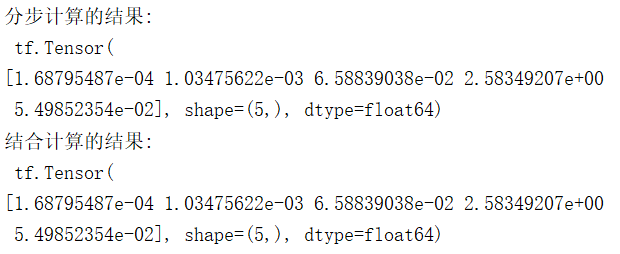
过拟合与欠拟合
欠拟合:模型不能有效拟合数据集,对现有数据集学习的不彻底。
欠拟合的解决方法:
- 增加输入特征项
- 增加网络参数
- 减少正则化参数
过拟合:模型对当前数据拟合的太好了,见到个新数据却难以做到合适的判断,缺少泛化力。
过拟合的解决方法:
- 数据清洗
- 增大训练集
- 采用正则化
- 增大正则化参数
正则化:缓解过拟合
正则化:在损失函数中引入模型复杂度指标,利用给W加权值,弱化了训练数据的噪声(一般不正则化b)

loss(w)是需要正则化的参数。计算方式有两种:
$$\operatorname{loss}_{L_{1}}(w)=\sum_{i}\left|w_{i}\right|$$
$$\operatorname{loss}_{L 2}(w)=\sum_{i}\left|w_{i}^{2}\right|$$
使用正则化后,loss变成两部分的和。
正则化的选择
- L1正则化大概率会使很多参数变为零,因此该方法可通过稀疏参数,即减少参数的数量,降低复杂度。
- L2正则化会使参数很接近零但不为零,因此该方法可通过减小参数值的大小降低复杂度。
下面来看L2正则化计算loss w的过程:
tf.nn.l2_loss(w)
代码示例,未采用正则化p29_regularizationfree.py
# 导入所需模块
import tensorflow as tf
from matplotlib import pyplot as plt
import numpy as np
import pandas as pd
# 读入数据/标签 生成x_train y_train
df = pd.read_csv('dot.csv')
x_data = np.array(df[['x1', 'x2']])
y_data = np.array(df['y_c'])
# reshape(-1,x) -1是将一维数组转换为二维的矩阵,并且第二个参数是表示分成几列,
# 但是在reshape的时候必须让数组里面的个数和shape的函数做取余时值为零才能转换
x_train = np.vstack(x_data).reshape(-1,2)
y_train = np.vstack(y_data).reshape(-1,1) #将y_data转换为二维数组
Y_c = [['red' if y else 'blue'] for y in y_train] # 三元运算
# 转换x的数据类型,否则后面矩阵相乘时会因数据类型问题报错
x_train = tf.cast(x_train, tf.float32)
y_train = tf.cast(y_train, tf.float32)
# from_tensor_slices函数切分传入的张量的第一个维度,生成相应的数据集,使输入特征和标签值一一对应
train_db = tf.data.Dataset.from_tensor_slices((x_train, y_train)).batch(32)
# 生成神经网络的参数,输入层为2个神经元,隐藏层为11个神经元,1层隐藏层,输出层为1个神经元
# 隐藏层11个神经元为人为指定
# 用tf.Variable()保证参数可训练
w1 = tf.Variable(tf.random.normal([2, 11]), dtype=tf.float32) # 隐藏层2个输入,11个输出
b1 = tf.Variable(tf.constant(0.01, shape=[11])) # b的个数与w个数相同
w2 = tf.Variable(tf.random.normal([11, 1]), dtype=tf.float32) # 输出层接收11个,输出1个
b2 = tf.Variable(tf.constant(0.01, shape=[1]))
lr = 0.01 # 学习率
epoch = 400 # 循环轮数
# 训练部分
for epoch in range(epoch):
for step, (x_train, y_train) in enumerate(train_db):
with tf.GradientTape() as tape: # 记录梯度信息
h1 = tf.matmul(x_train, w1) + b1 # 记录神经网络乘加运算
h1 = tf.nn.relu(h1) # relu激活函数
y = tf.matmul(h1, w2) + b2
# 采用均方误差损失函数mse = mean(sum(y-out)^2)
loss = tf.reduce_mean(tf.square(y_train - y))
# 计算loss对各个参数的梯度
variables = [w1, b1, w2, b2]
grads = tape.gradient(loss, variables)
# 实现梯度更新
# w1 = w1 - lr * w1_grad tape.gradient是自动求导结果与[w1, b1, w2, b2] 索引为0,1,2,3
w1.assign_sub(lr * grads[0])
b1.assign_sub(lr * grads[1])
w2.assign_sub(lr * grads[2])
b2.assign_sub(lr * grads[3])
# 每20个epoch,打印loss信息
if epoch % 20 == 0:
print('epoch:', epoch, 'loss:', float(loss))
# 预测部分
print("*******predict*******")
# xx在-3到3之间以步长为0.01,yy在-3到3之间以步长0.01,生成间隔数值点
xx, yy = np.mgrid[-3:3:.1, -3:3:.1]
# 将xx , yy拉直,并合并配对为二维张量,生成二维坐标点
grid = np.c_[xx.ravel(), yy.ravel()]
grid = tf.cast(grid, tf.float32)
# 将网格坐标点喂入神经网络,进行预测,probs为输出
probs = []
for x_test in grid:
# 使用训练好的参数进行预测
h1 = tf.matmul([x_test], w1) + b1
h1 = tf.nn.relu(h1)
y = tf.matmul(h1, w2) + b2 # y为预测结果
probs.append(y)
# 取第0列给x1,取第1列给x2
x1 = x_data[:, 0]
x2 = x_data[:, 1]
# probs的shape调整成xx的样子
probs = np.array(probs).reshape(xx.shape)
plt.scatter(x1, x2, color=np.squeeze(Y_c)) # squeeze去掉纬度是1的纬度,相当于去掉[['red'],['blue']],内层括号变为['red','blue']
# 把坐标xx yy和对应的值probs放入contour<[‘kɑntʊr]>函数,给probs值为0.5的所有点上色 plt点show后 显示的是红蓝点的分界线
plt.contour(xx, yy, probs, levels=[.5]) # 画出probs值为0.5轮廓线,levels:这个参数用于显示具体哪几条登高线
plt.show()
# 读入红蓝点,画出分割线,不包含正则化
# 不清楚的数据,建议print出来查看
运行结果
epoch: 0 loss: 1.6901788711547852
epoch: 20 loss: 0.06456395983695984
epoch: 40 loss: 0.0639718547463417
epoch: 60 loss: 0.054891664534807205
epoch: 80 loss: 0.037164993584156036
epoch: 100 loss: 0.0290686022490263
epoch: 120 loss: 0.026631897315382957
epoch: 140 loss: 0.025654718279838562
epoch: 160 loss: 0.025450214743614197
epoch: 180 loss: 0.02445397339761257
epoch: 200 loss: 0.02315516769886017
epoch: 220 loss: 0.02262507937848568
epoch: 240 loss: 0.02210732363164425
epoch: 260 loss: 0.02202308177947998
epoch: 280 loss: 0.022013641893863678
epoch: 300 loss: 0.02216213382780552
epoch: 320 loss: 0.02226211130619049
epoch: 340 loss: 0.022413412109017372
epoch: 360 loss: 0.022659024223685265
epoch: 380 loss: 0.02281317301094532
*******predict*******
代码示例,在训练部分采用L2正则化
# 导入所需模块
import tensorflow as tf
from matplotlib import pyplot as plt
import numpy as np
import pandas as pd
# 读入数据/标签 生成x_train y_train
df = pd.read_csv('dot.csv')
x_data = np.array(df[['x1', 'x2']])
y_data = np.array(df['y_c'])
x_train = x_data
y_train = y_data.reshape(-1, 1)
Y_c = [['red' if y else 'blue'] for y in y_train]
# 转换x的数据类型,否则后面矩阵相乘时会因数据类型问题报错
x_train = tf.cast(x_train, tf.float32)
y_train = tf.cast(y_train, tf.float32)
# from_tensor_slices函数切分传入的张量的第一个维度,生成相应的数据集,使输入特征和标签值一一对应
train_db = tf.data.Dataset.from_tensor_slices((x_train, y_train)).batch(32)
# 生成神经网络的参数,输入层为4个神经元,隐藏层为32个神经元,2层隐藏层,输出层为3个神经元
# 用tf.Variable()保证参数可训练
w1 = tf.Variable(tf.random.normal([2, 11]), dtype=tf.float32)
b1 = tf.Variable(tf.constant(0.01, shape=[11]))
w2 = tf.Variable(tf.random.normal([11, 1]), dtype=tf.float32)
b2 = tf.Variable(tf.constant(0.01, shape=[1]))
lr = 0.01 # 学习率为
epoch = 400 # 循环轮数
# 训练部分
for epoch in range(epoch):
for step, (x_train, y_train) in enumerate(train_db):
with tf.GradientTape() as tape: # 记录梯度信息
h1 = tf.matmul(x_train, w1) + b1 # 记录神经网络乘加运算
h1 = tf.nn.relu(h1)
y = tf.matmul(h1, w2) + b2
# 采用均方误差损失函数mse = mean(sum(y-out)^2)
loss_mse = tf.reduce_mean(tf.square(y_train - y))
# 添加l2正则化
loss_regularization = []
# tf.nn.l2_loss(w)=sum(w ** 2) / 2
loss_regularization.append(tf.nn.l2_loss(w1))
loss_regularization.append(tf.nn.l2_loss(w2))
# 求和
# 例:x=tf.constant(([1,1,1],[1,1,1]))
# tf.reduce_sum(x)
# >>>6
# loss_regularization = tf.reduce_sum(tf.stack(loss_regularization))
loss_regularization = tf.reduce_sum(loss_regularization)
loss = loss_mse + 0.03 * loss_regularization # REGULARIZER = 0.03
# 计算loss对各个参数的梯度
variables = [w1, b1, w2, b2]
grads = tape.gradient(loss, variables)
# 实现梯度更新
# w1 = w1 - lr * w1_grad
w1.assign_sub(lr * grads[0])
b1.assign_sub(lr * grads[1])
w2.assign_sub(lr * grads[2])
b2.assign_sub(lr * grads[3])
# 每200个epoch,打印loss信息
if epoch % 20 == 0:
print('epoch:', epoch, 'loss:', float(loss))
# 预测部分
print("*******predict*******")
# xx在-3到3之间以步长为0.01,yy在-3到3之间以步长0.01,生成间隔数值点
xx, yy = np.mgrid[-3:3:.1, -3:3:.1]
# 将xx, yy拉直,并合并配对为二维张量,生成二维坐标点
grid = np.c_[xx.ravel(), yy.ravel()]
grid = tf.cast(grid, tf.float32)
# 将网格坐标点喂入神经网络,进行预测,probs为输出
probs = []
for x_predict in grid:
# 使用训练好的参数进行预测
h1 = tf.matmul([x_predict], w1) + b1
h1 = tf.nn.relu(h1)
y = tf.matmul(h1, w2) + b2 # y为预测结果
probs.append(y)
# 取第0列给x1,取第1列给x2
x1 = x_data[:, 0]
x2 = x_data[:, 1]
# probs的shape调整成xx的样子
probs = np.array(probs).reshape(xx.shape)
plt.scatter(x1, x2, color=np.squeeze(Y_c))
# 把坐标xx yy和对应的值probs放入contour<[‘kɑntʊr]>函数,给probs值为0.5的所有点上色 plt点show后 显示的是红蓝点的分界线
plt.contour(xx, yy, probs, levels=[.5])
plt.show()
# 读入红蓝点,画出分割线,包含正则化
# 不清楚的数据,建议print出来查看
运行结果
epoch: 0 loss: 1.530280351638794
epoch: 20 loss: 0.7782743573188782
epoch: 40 loss: 0.6781619191169739
epoch: 60 loss: 0.5953636765480042
epoch: 80 loss: 0.5263288617134094
epoch: 100 loss: 0.4674427807331085
epoch: 120 loss: 0.41659849882125854
epoch: 140 loss: 0.37269479036331177
epoch: 160 loss: 0.3337797522544861
epoch: 180 loss: 0.3002385199069977
epoch: 200 loss: 0.27038004994392395
epoch: 220 loss: 0.24350212514400482
epoch: 240 loss: 0.22041508555412292
epoch: 260 loss: 0.20032131671905518
epoch: 280 loss: 0.1829461306333542
epoch: 300 loss: 0.16758175194263458
epoch: 320 loss: 0.15422624349594116
epoch: 340 loss: 0.14259028434753418
epoch: 360 loss: 0.13238896429538727
epoch: 380 loss: 0.12349270284175873
*******predict*******
补充内容:python matplotlib contour画等高线图
https://blog.csdn.net/Mr_Cat123/article/details/80677525
神经网络参数优化器:引导神经网络更新参数的工具
优化器:是引导神经网络更新参数的工具
作用:用来更新和计算影响模型训练和模型输出的网络参数,使其逼近或达到最优值,从而最小化(或最大化)损失函数
待优化参数w,损失函数loss, 学习率lr, 每次迭代个batch(每个batch包含2^n组数据),t表示当前batch迭代的总次数:
1.计算t时刻损失函数关于当前参数的梯度 $$ g_{t}=\nabla \operatorname{loss}=\frac{\partial \operatorname{loss}}{\partial\left(w_{t}\right)} $$ 2.计算t时刻一阶动量mt和二阶动量Vt
- 一阶动量:与梯度相关的函数
- 二阶动量:与梯度平方相关的函数
3.计算t时刻下降梯度: $$ \eta_{\mathrm{t}}=l r \cdot m_{\mathrm{t}} / \sqrt{V_{\mathrm{t}}} $$ 4.计算t+1时刻参数 $$ w_{\mathrm{t}+1}=w_{t}-\eta_{t}=w_{t}-l r \cdot m_{t} / \sqrt{V_{t}} $$ 不同的优化器实质上只是定义了不同的一阶动量和二阶动量公式
SGD 随机梯度下降
SGD (无momentum),常用的梯度下降法。 $$ m_{\mathrm{t}}=g_{\mathrm{t}} \quad V_{\mathrm{t}}=1 $$
$$\boldsymbol{\eta}_{\mathrm{t}}=\boldsymbol{l} \boldsymbol{r} \cdot \boldsymbol{m}_{\mathrm{t}} / \sqrt{\boldsymbol{V}_{t}}=\boldsymbol{l} \boldsymbol{r} \cdot \boldsymbol{g}_{t}$$
$$ \begin{aligned} w_{t+1}=& w_{t}-\eta_{t} \ &=w_{t}-l r \cdot m_{t} / \sqrt{v_{t}}=w_{t}-lr \cdot g_{t} \end{aligned} $$
即为 $$m_{\mathrm{t}}=\beta \cdot m_{t-1}+(1-\beta) \cdot g_{t}$$
SGDM
( SGDM (含momentum的SGD),在SGD基础上增加一 阶动量。 $$ m_{\mathrm{t}}=\beta \cdot m_{t-1}+(1-\beta) \cdot g_{t} $$ mt:表示各时刻梯度方向的指数滑动平均值
β:超参数,趋近于1,经验值为0.9 $$ V_{\mathrm{t}}=1 $$
$$ \begin{aligned} \eta_{\mathrm{t}}=& \operatorname{lr} \cdot m_{\mathrm{t}} / \sqrt{V_{\mathrm{t}}}=\operatorname{lr} \cdot m_{\mathrm{t}} \ &=\operatorname{lr} \cdot\left(\beta \cdot m_{\mathrm{t}-1}+(1-\beta) \cdot g_{\mathrm{t}}\right) \end{aligned} $$
$$ \begin{aligned} w_{\mathrm{t}+1}=& w_{\mathrm{t}}-\eta_{\mathrm{t}} \ &=w_{\mathrm{t}}-l r \cdot\left(\beta \cdot m_{\mathrm{t}-1}+(1-\beta) \cdot g_{\mathrm{t}}\right) \end{aligned} $$
Adagrad
Adagrad, 在SGD基础上增加二阶动量 $$ m_{\mathrm{t}}=g_{\mathrm{t}} $$ 二阶动量是从开始到现在梯度平方的累计和: $$ V_{t}=\sum_{\tau=1}^{t} g_{\tau}^{2} $$
$$ \begin{array}{l} \eta_{\mathrm{t}}=lr \cdot m_{t} /(\sqrt{V_{t}}) \ \quad=lr \cdot g_{t} /(\sqrt{\sum_{\tau=1}^{t} g_{t}^{2}}) \end{array} $$
$$ \begin{aligned} w_{t+1}=& w_{t}-\eta_{t} \ &=w_{t}-lr \cdot g_{t} /(\sqrt{\sum_{\tau=1}^{t} g_{t}^{2}}) \end{aligned} $$
RMSProp
RMSProp, SGD基础上增加二 阶动量 $$ m_{\mathrm{t}}=g_{\mathrm{t}} $$ 二阶动量v使用指数滑动平均值计算,表征的是过去一段时间的平均值 $$ V_{t}=\beta \cdot V_{t-1}+(1-\beta) \cdot g_{t}^{2} $$
$$ \begin{aligned} \eta_{t}=& l r \cdot m_{\mathrm{t}} / \sqrt{V_{\mathrm{t}}} \ &=lr \cdot g_{t} /(\sqrt{\beta \cdot V_{t-1}+(1-\beta) \cdot g_{t}^{2}}) \end{aligned} $$
$$ \begin{aligned} w_{t+1} &=w_{t}-\eta_{t} \ &=w_{t}-lr \cdot g_{t} /(\sqrt{\beta \cdot V_{t-1}+(1-\beta) \cdot g_{t}^{2}}) \end{aligned} $$
Adam
Adam,同时结合SGDM一阶动量和RMSProp二阶动量
一阶动量: $$ m_{\mathrm{t}}=\beta_{1} \cdot m_{t-1}+\left(1-\beta_{1}\right) \cdot g_{t} $$ 修正一阶动量的偏差,t为从训练开始到当前时刻所经历的总batch数:: $$\widehat{m}_{\mathrm{t}}=\frac{m_{\mathrm{t}}}{1-\beta_{1}^{t}}$$ 二阶动量: $$V_{t}=\beta_{2} \cdot V_{s t e p-1}+\left(1-\beta_{2}\right) \cdot g_{t}^{2}$$ 修正二阶动量的偏差,t为从训练开始到当前时刻所经历的总batch数: $$\widehat{V_{t}}=\frac{V_{t}}{1-\beta_{2}^{t}}$$
$$\begin{aligned}
\eta_{t}=& lr \cdot \widehat{m}_{\mathrm{t}} / \sqrt{\widehat{V}_{t}} \\
&=\operatorname{lr} \cdot \frac{m_{\mathrm{t}}}{1-\beta_{1}^{t}} / \sqrt{\frac{V_{t}}{1-\beta_{2}^{t}}}
\end{aligned}$$
$$\begin{aligned}
w_{t+1} &=w_{t}-\eta_{t} \\
&=w_{t}-l r \cdot \frac{m_{t}}{1-\beta_{1}^{t}} / \sqrt{\frac{v_{t}}{1-\beta_{2}^{t}}}
\end{aligned}$$
优化器对比
class2中代码p32-p40
SGD
loss图像
acc图像
耗时:12.678699254989624
SGDM
loss图像
acc图像
耗时:17.32265305519104
Adagrad
loss图像
acc图像
耗时:13.080469131469727
RMSProp
loss图像
acc图像
耗时:16.42955780029297
Adam
loss图像
acc图像
耗时:22.04225492477417
